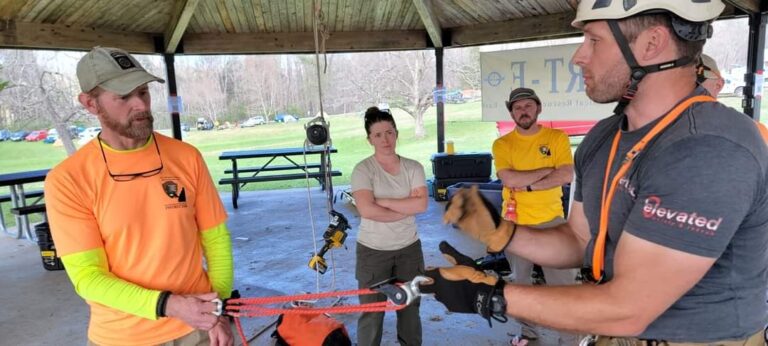Coaching and Training: The Dual Lifeline of Rope Rescue and Rigging
In the demanding and dynamic field of rope rescue and rigging, the difference between coaching and training is not just a matter of terminology—it’s a matter of operational excellence. These two approaches, when combined, form the backbone of a robust development framework that can mean the difference between life and death in critical situations.
While training provides the structured knowledge and foundational skills necessary to operate effectively, coaching fine-tunes these capabilities, enabling rescue professionals to adapt and thrive in the face of unpredictable real-world challenges.
Training: The Foundation of Expertise
Training is the structured cornerstone of any rope rescue professional’s journey. Its goal is to impart critical knowledge and practical skills in a controlled learning environment. Here’s what makes training indispensable:
- Structured Learning
- Training programs follow a well-organized curriculum, covering essential topics such as:
- Knot tying and rope management
- Equipment operation and safety protocols
- Anchor point selection and mechanical advantage systems
- Training programs follow a well-organized curriculum, covering essential topics such as:
- Certification and Compliance
- Certifications like NFPA 1006 validate a trainee’s proficiency and adherence to industry standards. These certifications often involve rigorous written and practical assessments.
- Safety-Centric Focus
- Safety is the backbone of rope rescue training. Programs instill an acute awareness of risk management, teaching protocols that minimize hazards and ensure the welfare of rescuers and victims alike.
- Technical Mastery
- Training hones critical technical skills, such as:
- Rigging systems for high-angle and confined space rescues
- Effective use of belay and haul systems
- Proper operation of mechanical advantage tools like pulleys and winches
- Training hones critical technical skills, such as:
- Collaborative Environment
- Delivered in group settings, training promotes teamwork, with instructors offering real-time guidance and assessments.
Coaching: The Art of Mastery
Coaching transcends the structured boundaries of training, focusing on the individual or team’s growth and adaptability. It takes skills from proficient to exceptional through hands-on, customized guidance. Key aspects of coaching include:
- Skill Refinement
- Coaching identifies areas for improvement and sharpens specific skills through personalized attention. It bridges the gap between “good” and “expert.”
- Real-World Application
- Coaches simulate complex rescue scenarios, enabling participants to:
- Apply learned skills in high-pressure situations
- Adapt to unforeseen challenges
- Improve decision-making under duress
- Coaches simulate complex rescue scenarios, enabling participants to:
- Problem-Solving Development
- Coaching emphasizes critical thinking and problem-solving:
- Addressing rigging challenges in the field
- Overcoming equipment failures or environmental obstacles
- Enhancing situational awareness
- Coaching emphasizes critical thinking and problem-solving:
- Continuous Feedback
- Coaches provide ongoing, constructive feedback to:
- Highlight areas of strength and improvement
- Encourage adaptive strategies in diverse rescue contexts
- Build confidence and resilience
- Coaches provide ongoing, constructive feedback to:
- Customization
- Unlike training, coaching tailors the approach to:
- Address specific weaknesses
- Focus on unique team dynamics
- Strengthen leadership skills within the group
- Unlike training, coaching tailors the approach to:
Why Both Are Crucial in Rope Rescue and Rigging
- Training Without Coaching
While training lays the groundwork, it doesn’t always prepare professionals for the nuanced realities of live rescue operations. Without coaching, skills may remain theoretical or underdeveloped in dynamic scenarios. - Coaching Without Training
Coaching relies on a solid foundation. Without prior training, coaching lacks the necessary baseline knowledge and skillset to build upon.
Together, training and coaching form a synergistic loop:
- Training provides knowledge and certification.
- Coaching refines adaptability, problem-solving, and execution under pressure.
Real-World Application Across Sectors
- Fire Service
Training ensures firefighters meet NFPA standards, while coaching enhances their ability to manage high-angle rescues or rapidly changing fireground conditions. - Search and Rescue (SAR)
Training equips SAR teams with standardized protocols, while coaching develops their ability to work seamlessly in remote, unpredictable environments. - Industrial Rescue
Training imparts the technical skills required for confined space rescues, and coaching helps workers navigate the complexities of industrial sites and their hazards. - Wilderness Rescue
Training teaches fundamentals like navigation and rigging, while coaching prepares teams to adapt to the challenges of unpredictable terrain and weather.
A Unified Approach: Maximizing Growth
Combining training and coaching offers a holistic development approach that ensures safety, efficiency, and excellence in rope rescue and rigging:
- Before Operations
Training establishes the foundation through certifications and skill acquisition. - During Operations
Coaching refines and adapts skills in real-time scenarios. - After Operations
Continuous coaching evaluates performance, addresses challenges, and promotes long-term growth.
Take the Next Step
To thrive in rope rescue and rigging, embrace the power of training and coaching. These complementary approaches ensure you’re not just prepared—but equipped to excel in even the most demanding situations.
Get your Training – Rigging Lab Academy
Get your Gear – Rescue Response Gear
Peace on your Days
Lance









